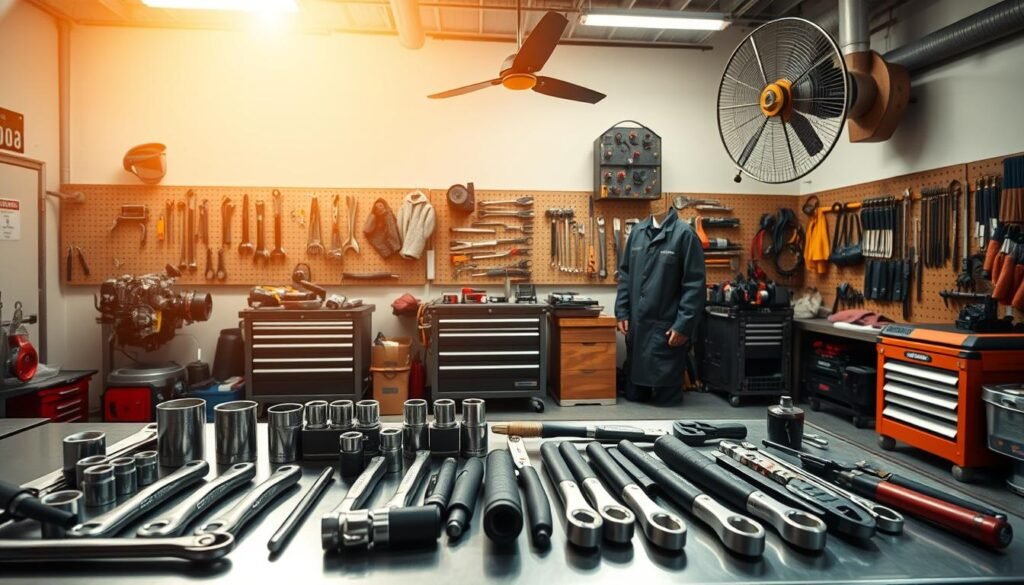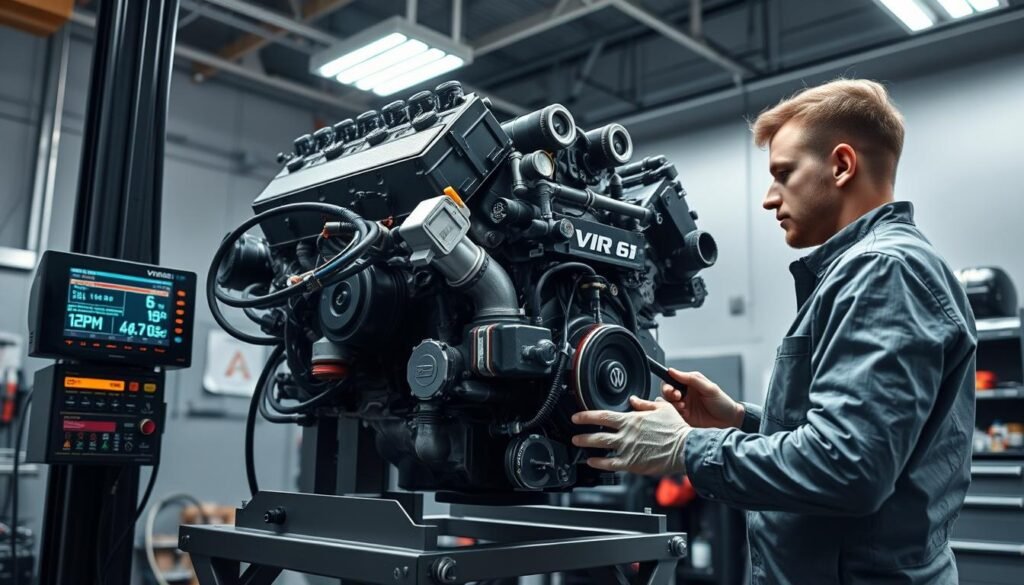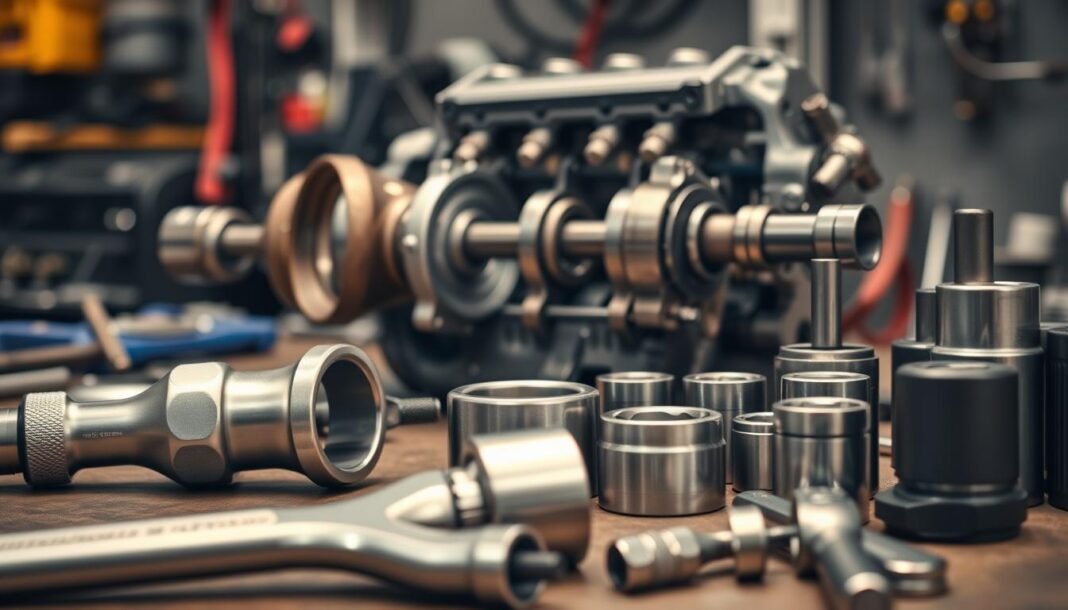Replacing rod bearings in a 3.2-liter VR6 engine is a meticulous task requiring precision to maintain engine performance. Proper installation ensures the connecting rods remain straight and aligned, with bores sized correctly for wrist pins and crankshaft pins. Before starting, mark all components to avoid mixing parts and inspect surfaces for wear. This guide covers how to replace rod bearings in 3.2l vr6 engines, focusing on steps like measuring bearing clearances and verifying oil clearance specs.
Key steps include checking crankshaft run-out with a dial gauge and using Plastigage to measure bearing clearances. Following these methods prevents costly errors and ensures the VR6 engine rod bearing replacement meets factory standards. This DIY rod bearings VR6 project demands patience but rewards with a reliable engine rebuild.
Key Takeaways
- Mark all components to avoid mixing bearing caps or rods.
- Measure bearing clearances at 90-degree angles to parting lines.
- Use Plastigage for quick checks of main bearing clearances.
- Ensure crankshaft run-out stays under 0.030 mm to avoid replacements.
- Calibrate tools and use consistent lubricants during installation.
Materials and Tools Required for Rod Bearing Replacement
Before diving into 3.2 liter VR6 bearings work, gather every tool and part listed here. Skipping this step risks costly mistakes during engine reassembly VR6. Start by organizing your workspace and checking each item’s condition.
- Engine stand (for stable engine cradling)
- Cylinder bore gauge and micrometers
- Socket set (Metric and standard sizes)
- Magnetic pickup tool (for small parts)
- Cleaning rags and aerosol degreaser
“Always compare aftermarket bearings to OEM specs. Even a .001” tolerance variance can affect clearances.” – ASE-certified engine specialist
For bearings, choose brands like Federal-Mogul or Mahle. Their 3.2 liter VR6 bearings often include installation guides. Lubricate bearings with high-viscosity engine assembly lube (e.g., Lucas Oil 1004). Never substitute with standard motor oil.)
DIY engine maintenance pros recommend marking each bearing cap with corresponding cylinder numbers. This prevents misalignment during engine reassembly VR6. Use a sharpie or numbered tags for tracking.
- Bearings (complete set with retainers)
- Engine-specific gasket set
- Threadlocking compound (blue Loctite)
- Disposable nitrile gloves
Invest in a magnetic parts tray to keep tiny components organized. Misplaced shims or bearings delay projects and increase error risks. Double-check torque wrench calibration before starting.
Prepping Your VR6 Engine for DIY Work
Before diving into any VR6 engine repair, proper preparation ensures precision. Start by securing the engine on a sturdy stand to avoid movement. A stable base prevents misalignment during later steps.
“Cleaning oil passages is critical to preventing post-repair blockages.”
Begin by disconnecting all components attached to the engine block. Use a DIY engine maintenance checklist to track removed parts. Clean each oil passage with a soft brush and compressed air to remove old debris. A flashlight helps inspect hard-to-see areas for leftover grime.
Inspect bearing seat surfaces for scoring or corrosion. Damaged surfaces require grinding or replacement. Here’s a quick guide:
- Wipe surfaces with a lint-free cloth
- Check for warping using a straightedge
- Mark damaged areas for reference
| Step | Action | Why It Matters |
|---|---|---|
| 1 | Secure engine on stand | Prevents accidental shifts during work |
| 2 | Clean all oil pathways | Ensures proper lubrication post-repair |
| 3 | Inspect bearing seats | Averts costly rework from overlooked damage |
A thorough prep session now saves time and money later. Keep a log of findings for reference during assembly. Skipping these steps risks compromising the success of your VR6 engine repair project.
Safety Precautions and Best Practices
Working on a VR6 engine repair demands strict adherence to safety protocols. Prioritizing DIY engine safety ensures both your well-being and the engine’s integrity. Follow these guidelines to avoid mishaps during the project.
Personal Protective Gear
Essential gear includes:
- Heavy-duty gloves to guard hands from sharp metal edges.
- ANSI-rated safety glasses to block flying particles.
- Fire-resistant clothing to prevent oil or chemical exposure.
Wear closed-toed shoes and avoid loose jewelry that could snag on parts.
Setting Up a Safe Workspace
A clutter-free engine workshop setup reduces risks. Follow these steps:
- Create a dedicated work area with good lighting and ventilation.
- Use drip pans to contain spills and prevent slips.
- Organize tools in labeled bins to save time and avoid misplacement.
- Keep a fire extinguisher nearby and secure all flammable materials.

Regularly clear debris and double-check tool placement before handling heavy components. A safe environment fosters precision and confidence throughout the VR6 engine repair process.
Step-by-Step Guide to Removing Old Bearings
Starting rod bearing removal demands precision to avoid damaging critical engine parts. Follow these organized steps to ensure a smooth process for your VR6 engine repair.
Draining Engine Oil and Fluids
Before accessing bearings, drain all fluids. Place a drain pan under the oil pan and remove the magnetic drain plug to collect metal debris. Drain coolant if needed, but avoid disturbing bearing components.
Removing Bolts and Components
- Loosen and remove main bearing caps in a specific sequence to maintain alignment. Use a torque wrench for consistent pressure.
- Label each cap and its position with numbered tags. Precision here prevents errors during engine reassembly VR6.
- Gently pry bearings from journals using a plastic punch to avoid scratching metal surfaces.
Keep all components in order—use a clean tray to organize parts as you remove them. A VR6 engine repair requires every piece to return to its original spot. Double-check that no residue blocks bearing seats before proceeding.
How to Replace Rod Bearings in 3.2l vr6
Replacing the 3.2 liter VR6 bearings requires precision to ensure engine durability. Follow these steps to avoid misalignment and damage:
Positioning and Installing the New Bearings
- Align the bearing halves so oil holes match the engine block’s passages. Verify locating lugs fit snugly into their slots.
- Install bearings one at a time, pressing them fully into their bores using a plastic mallet. Check for even seating with a flashlight.
- Reassemble main caps in original positions, starting with the center bearing. Torque bolts in sequence using manufacturer specs, moving outward.
| Correct Method | Common Mistakes |
|---|---|
| Align oil holes for proper lubrication | Ignoring oil hole alignment |
| Hand-tighten bolts before final torque | Overtightening during initial setup |
| Check crankshaft rotation after each cap installation | Skipping intermediate checks |
Proper Lubrication Techniques
- Apply assembly lube evenly to bearing surfaces and the rear main seal lip. Avoid excess to prevent slinging during startup.
- Use high-pressure engine oil or moly-based lubricant for initial startup protection. Wipe off any drips before reassembly.
- Rotate the crankshaft manually after bearings are installed to confirm smooth movement without binding.
Skipping these steps risks bearing failure. Always double-check bearing orientation and oil path alignment. Proper torque sequence and lube application are critical for the DIY rod bearings VR6 project’s success.
Inspecting and Cleaning Engine Components
Cleaning is a critical step in VR6 engine maintenance. Before reassembly, every part must be free of debris. Start by using an industrial cleaner to dissolve old grease. Spray solvents into oil passages to remove stubborn residue. Brushes with brass bristles work best for tight spaces—avoid metal tools to prevent scratches.
- Soak components in degreasing solution for 15–20 minutes.
- Use compressed air to blast away dust from crankshaft grooves.
- Check all surfaces for scratches or pitting with a magnifying glass.
Inspect critical areas like the cylinder walls and bearing journals. Uneven surfaces reduce bearing lifespan—measure roundness with a dial bore gauge. Ensure all bolt threads are intact; damaged threads require replacement. Cleaned parts should feel smooth to the touch, free of any grit. Proper engine cleaning VR6 ensures components fit correctly during reassembly.
After cleaning, organize parts by location using a labeled tray system. This prevents mix-ups during engine reassembly VR6. Wipe down the block with a lint-free cloth soaked in clean engine oil to protect metal surfaces until reassembly. Skipping this step risks contamination, leading to premature wear.
Reassembling and Installing New Bearings
Proper engine reassembly VR6 demands precision to avoid misalignment or damage. Start by reattaching components in the exact reverse order of disassembly. Clean all mating surfaces before reinstalling parts to ensure airtight seals.
Reattaching Components in Order
- Position the oil pan gasket and secure the pan using factory torque specs.
- Reinstall main bearing caps in sequence, aligning dowel pins first.
- Mount cylinder heads last, ensuring valve timing marks align with the crankshaft.
Final Alignment and Torque Specifications
Use a torque wrench to tighten bearing caps in a crisscross pattern. Follow VR6 engine repair manuals for exact values—typically 25-30 ft-lbs for main bearings. Rotate the crankshaft manually after each cap is installed to check for smooth movement.
Verify piston-to-valve clearance by rocking the engine with a wrench. Lubricate all threads with engine-specific assembly paste. Double-check engine bearing installation alignment with a dial indicator if available.
Tip: Store disassembled parts in labeled containers during reassembly to prevent confusion. A misaligned timing chain or loose accessory belt can undo hours of work, so take breaks if needed.
Troubleshooting Common Issues
Even after careful installation, VR6 troubleshooting might be needed. Common issues often stem from minor oversights during the rod bearing replacement process. Watch for symptoms like rough idling, overheating, or unusual noises after reassembly.
Identifying Installation Errors
- Check for rod bearing replacement errors like misaligned bearings or incorrect torque on bolts.
- Verify bearing clearances with a dial indicator—improper gaps cause engine performance issues.
- Listen for knocking sounds, a sign of loose or worn bearings.
Solutions for Performance Problems
Address engine performance issues by:
- Rechecking bearing clearances using manufacturer specs.
- Ensuring crankshaft spins freely after reassembly—binding indicates misalignment.
- Re-lubricate all bearing surfaces before final assembly.
If issues persist, disassemble and inspect bearings under clean lighting. Compare them to factory examples for proper fitment.
Final Testing and Engine Performance Checks
Once everything’s back together, final checks ensure your VR6 runs smoothly. Start by cranking the engine with a fresh oil fill. Listen for even firing and watch oil pressure rise to spec on a gauge. Low pressure could signal a missed step in DIY engine maintenance.

- Rotate the crankshaft manually before startup. It should spin freely without resistance.
- Measure axial play using a micrometer. Clearances over 0.0015 inches need bearing adjustment.
- Run the engine at 2000 RPM for 5 minutes. Monitor oil pressure and temperature with a scan tool.
If unusual noises or leaks appear, shut down immediately. Reference your workshop manual for proper testing VR6 engine specs. Always use OEM gaskets and torque specs to avoid rework. Proper post-maintenance checks safeguard long-term engine performance VR6, preventing costly failures down the road.
Pro tip: After startup, check all reassembled components for tightness. Use a magnetic base torque wrench for precise adjustments. Regular DIY engine maintenance extends engine life and keeps power output optimized.
Conclusion
Finishing a VR6 engine DIY rod bearings project requires meticulous care. Proper reassembly ensures components align perfectly, so follow torque specs and lubrication guidelines. Quality parts like SP Main bearings with HD grooves optimize oil flow, reducing wear. Safety steps like double-checking clearances are vital before restarting the engine. If uncertain, seeking professional help avoids costly mistakes. A well-executed DIY engine repair improves performance and builds confidence. Precision during final steps like rod bearings finishing prevents future issues. With patience, your VR6 runs smoother, rewarding your effort with reliable power. Proper engine reassembly VR6 techniques extend lifespan and enhance reliability. Balancing attention to detail and safety secures long-term benefits from your hands-on work.




